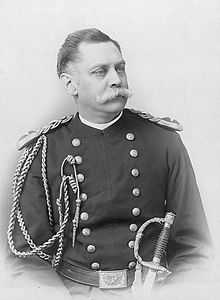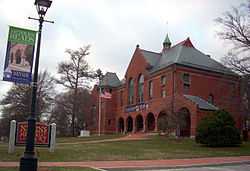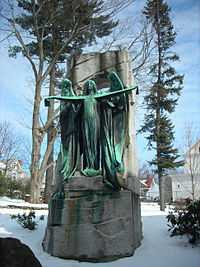Henry Coffin Nevins
| Henry Coffin Nevins | |
|---|---|
 Henry C. Nevins | |
| Born |
January 10, 1843 Methuen, Massachusetts |
| Died | June 25, 1892 (aged 49) |
Resting place | Mount Auburn Cemetery |
| Spouse(s) | Julia Du Gay |
| Children | none |
| Parent(s) | David Nevins, Sr. and Elizabeth Coffin Nevins |
Col. Henry Coffin Nevins (10 January 1843 – 25 June 1892) was an industrialist from an established New England family in the city of Methuen, Massachusetts.[1][2][3][4]
Life
Nevins was the son of David Nevins, Sr., who was born in Salem, New Hampshire on December 12, 1809, to John Nevins and Achsah Nevins née Swan. Henry Nevins' mother was Elizabeth 'Eliza' Coffin, the daughter of a wealthy merchant from the island of Nantucket named Jared Coffin.[2] David Sr., who built his personal wealth through importing and manufacturing textiles, gained notoriety as the co-owner of Pemberton Mill, the collapse of which in 1860 "is likely the worst industrial accident in Massachusetts history"[5] and "one of the worst industrial calamities in American history".[6][7]
Henry and elder brother David Nevins, Jr., took on ever-increasing responsibilities as their father aged. For a time Henry managed the City Exchange Banking Company, a Boston-based bank that was eventually merged with the Nevinses' other businesses. The "Methuen Duck Cloth" the Nevinses manufactured was world-renowned as a material for sail cloth and tents for the tropics.[2][8][9]


After David Sr.'s death in 1881, the family's wealth was such that his widow Eliza, his eldest son David C, Nevins, and his younger son Henry Coffin Nevins were able to erect the Nevins Memorial Library in his honor. David, Sr., and Eliza are buried on the library grounds beneath a memorial "Angel of Life" sculptured by George Moretti in 1896.[2][8][9]
Henry and David, Jr., expanded the manufacturing and importing businesses they had inherited. They built textile mills and owned the India Bagging Company and Bengal Bagging Company in Salem, Massachusetts, continued importing goods from Asia, and helped give the city of Methuen "much of its unique identity."[10]
Legacy
Henry Coffin Nevins married Julia Du Gay of Paris but they had no children. He was buried at Mount Auburn Cemetery beneath a limestone monument of cherubs and palm fronds designed by Augustus St. Gaudens.[11] At the cost of over fifty thousand dollars, his wife dedicated to her husband, in the nave of the local Congregationalist Church, "The Resurrection", a stained glass window designed by John LaFarge and "said to be (one of) his masterpieces."[9][12]
He was remembered posthumously in a recollection of:
...a beautiful summer day in 1889...The marshal of the procession on that occasion was the late Henry C. Nevins, whose untimely death a few years later was deeply mourned by the entire community. He was superbly mounted, sat his horse finely, and was directly in front of the orator of the day, listening to every word with that attentive urbanity so characteristic of him.[13]
With few close relatives, his wife became a widow philanthropist much like her sister-in-law Harriet Nevins. She left New England and lived an international life, establishing homes in Paris, at the Hotel Savoy in New York City, and Washington, D.C., where she died.[14]
Upon her death, "Mrs. Julie F.H. Nevins" willed funds for the construction of the Henry C. Nevins Home for Aged and Incurables, an old age home established in 1906.[15] Julia was living in New York City at the time of her death and the New York Times ran a story about her $1 million gift. The rest of her estate amounted to around $1.2 million and was inherited by her sister Antoinette Lees (wife of Capt. George Cholmondeley of the Grenadier Guards) in London, to her "faithful maid" Margaret Young, Werner von Blomberg's wife Eva, and others.[14] According to one author, "The public spirit and generosity of the Nevins family seems to have no bounds in the town in which they made their home".[2]
Mrs. Henry C. Nevins was buried with her husband in Cambridge, Massachusetts. Her will included provisions for "roses, Easter lilies, sweet peas, and pansies" to be displayed on the couple's grave on appropriate holidays.[14]
Henry Coffin Nevins' surname (as well as that of fellow "Methuen city fathers" Edward F. Searles and Charles H. Tenney) appears in the name of the "Searles Tenney Nevins Historic District" established by the City of Methuen in 1992 to preserve the "distinctive architecture and rich character of one of Massachusetts’ most unique neighborhoods". According to the City of Methuen:
Today, the trio’s collective vision can be seen in mills, housing, schools, mansions, churches, monuments, playgrounds, the library, and the architectural fantasies that resulted from their artistic rivalry. The historic district boundaries were established to include properties and buildings constructed or used by the Searles, Tenney and Nevins families and the people who worked for them.
[1]
According to a description by the Essex National Heritage Area, the district:
...reflects the major influences that shaped Methuen's architecture and economy. The Spicket River provided water power for the local industry housed in large brick mills along the river. Corresponding commercial growth resulted in Gaunt Square, which has been the commercial center of Methuen since the mid-19th century. In addition to economic forces, three individuals, David Nevins, Charles Tenney and Edward F. Searles, left an architectural legacy which defines the district's character today.
[16]
Notes
According to a 4 August 2008 communication from Sharon Morley, Reference Librarian at Nevins Memorial Library:
David Nevins Sr. was born in Salem NH on December 12, 1839 To John and Achsah Swan Nevins. When he reached 21, he moved to New Bedford and sold supplies to the crews of the whaling vessels. In 1818 (1835), Nevins married Eliza Coffin (born 1817). She was the daughter wealthy ship merchant Jared Coffin of Nantucket. Nevins later went into business importing cloth. In 1842, protective taxes began hurting the textile importing business, so Nevins switched to manufacturing textiles instead. In 1859, he purchased the ill-fated Pemberton Mill, and in 1864, he purchased the Methuen Cotton Company on the Spicket River. Mr. & Mrs. David Nevins Sr. and their two sons returned to the Methuen area in the early to mid 1860's. David Sr. Died in 1881 at the age of 72. His wife and sons had the Nevins Memorial Library built as a memorial to him. David Nevin's sons, David Jr. and Henry Coffin Nevins took over the manufacturing businesses when their father Died. David Jr. born JULY 30, 1839 ran the textile mills which by that time included India Bagging Company and Bengal Bagging Company in Salem, MA. Henry c. born on January 10, 1843 became the agent of the family's textile brokerage firm called Nevins and Company. Not only did the company sell the cloth from the Nevins' family mills, but by this time it was importing textiles from abroad. David Jr. Died in 1898 and Henry in 1892.
David Nevins Sr. born-Dec.12, 1809-died-March 19, 1881 Eliza Coffin Nevins born June 1, 1817 – died Dec. 30, 1895 David Nevins Jr. Born Jul 30, 1839 – Died Aug 24, 1898 Henry Coffin Nevins Born Jan. 10, 1843–Died June 25, 1892
References
- ↑ 1.0 1.1 Official Website of the City of Methuen
- ↑ 2.0 2.1 2.2 2.3 2.4 Genealogical and Personal Memoirs Relating to the Families of Boston and Eastern Massachusetts by William Richard Cutter, published by Lewis historical publishing company, 1908
- ↑ Cape Cod History
- ↑ Although sources refer to Nevins as "Colonel", no online details of his military career — if any — were found.
- ↑ Pemberton Mill Collapse, 1860
- ↑ Disaster in Lawrence: The Fall of the Pemberton Mill by Alvin F. Oickle
- ↑ New York Times January 21, 1860
- ↑ 8.0 8.1 Methuen Millionaires: Nevins
- ↑ 9.0 9.1 9.2 Methuen History: Bridges from the Past
- ↑ Historic District Brochure
- ↑ United States Department of the Interior, National Park Service
- ↑ Methuen Research
- ↑ Methuen History (Charles H. Tenney, commemorates)
- ↑ 14.0 14.1 14.2 New York Times April 5, 1904
- ↑ "National Register Information System". National Register of Historic Places. National Park Service. 2008-04-15.
- ↑ Essex National Heritage
